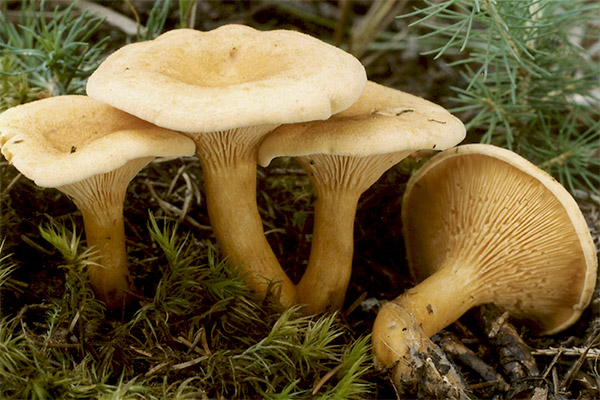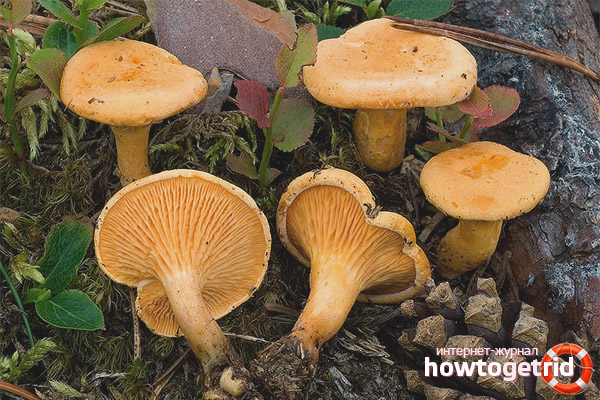The content of the article
Chanterelle is a mushroom widely known by the people, but there is also another masked mask successfully under it - an orange govorushka. In the common people kokoshka or false chanterelle is most often found in coniferous or mixed-type forests. Only an experienced mushroom picker can distinguish them from real chanterelles. If you do not have sufficient knowledge and recruit false chanterelles, then there is a chance of seriously poisoning.
False chanterelle description
- Flat cap from 1.5-6 cm in diameter, velvety to the touch, with slightly lowered edges. Mushroom saturated orange with a red tinge. For larger mushrooms the color of the cap is yellowish-beige, with a small dent in the center.
- The leg is thin and even, about 1 cm, in height - from 3-5 cm. It is colored the same color as the cap, at the base is brown.The inner part is vatoobrazny, fibrous.
- Under the cap, the frequent plates descend on the leg, the same color as the whole mushroom.
- The flesh is light with a pale yellow tinge. The smell is barely perceptible, mushroom.
The spread and seasonality of the fungus
False chanterelle is widespread in Europe, Asia and Russia. It grows mainly in cool places with an abundance of moisture, under rotting stumps and trees, in lowlands under the leaves.
Govorushki can be found growing one by one or in groups. They do not tolerate close proximity, and even with group germination are located at a short distance from each other.
Like most mushrooms, they begin to bear fruit from late summer to mid-autumn.
The main differences from similar species
One of the main differences of false chanterelles from real ones is color. In govorushek he bright orange or red-orange hue. The edible mushroom has a pale yellow, orange yellow or white yellow color,no obvious orange or red tones.
Unlike the velvety cap of a coconut, this chanterelle has a smooth surface. Another difference is the edges of the mushrooms. In orange govorushek they are smoothly rounded and even, in edible chanterelles they are undulating, with an irregular shape, moreover, the cap itself is larger.
In the false mushroom, the plates are oblong and descend to the pedicle, in chanterelles smoothly passing into it. In addition, the leg of an inedible fungus is much thinner, with a noticeable darkening closer to the base, in the present it is thicker, smoother, of one color and gradually narrows to the bottom.
The flesh of the orange talker is friable, uniform, yellowish in color, with slight pressure does not change the color. In a true chanterelle, the flesh is white, closer to the edges turns yellow, and if you slightly press on it, it becomes red. The smell is light, mushroom.
The nutritional value
Information about the suitability of this fungus is controversial, some sources claim that after heat treatment, kokoshki are suitable for human consumption. However, most still believe the opposite.As arguments, the facts about the low nutritional value of the fungus and the high risk of poisoning are given.
In order to protect themselves, orange govorushki soaked for several days, then boiled for about half an hour, and only then used for cooking. It has been scientifically proven that when exposed to temperature, toxins in their composition are destroyed, but the likelihood of poisoning remains. In addition, after such a number of treatments, the soft pulp of the fungus turns into a mushy mass.
Symptoms in case of poisoning
In the composition of the false chanterelles are toxic substances that affect the work of the organs of the gastrointestinal tract, liver, and kidneys.
Mushrooms that have passed all stages of pre-treatment, not rarely cause poisoning. In the case of use in cooking, without soaking and boiling, poor health is guaranteed.
Depending on age and weight, the first signs of intoxication may appear in half an hour or within 3 hours after eating a false chanterelle. In rare cases, the symptoms of poisoning manifested a day after eating.
Characteristic signs of poisoning:
- diarrhea;
- weakness;
- nausea and vomiting;
- stomachache.
In case of poisoning in any case should not engage in self-treatment, you should contact the experts, because there is a threat of botulism.
Beginner mushroom pickers bypass chanterelles with a side, since it is likely to pick up its poisonous counterpart. Kokoshka does not have a pronounced mushroom taste, which once again makes you wonder whether it is worth risking your health to try it.
Video: mock fox (Hygrophoropsis aurantiaca)












To send